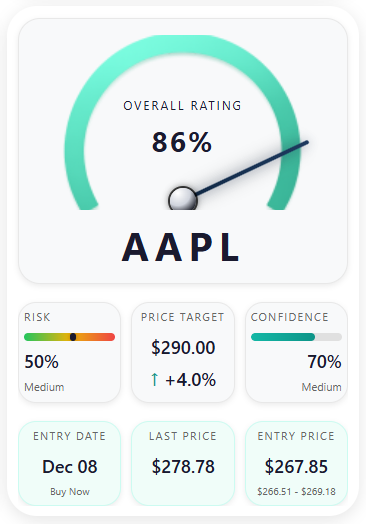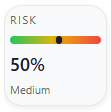Your Personal AI Financial Advisor
(Without the $300/hr Price Tag)
- A simple shortlist of what's most worth your attention
- Insights personalized just for you
- Delivered at the moments they matter most
Start Your Free Trial
🛡️
30-Day Money Back Guarantee
Beat the Market or Cancel and Pay Nothing
Our AI Never Sleeps
Updates 24/7/365, 100s of ratings per day
3X
Oct Returns vs SPY
3X
Nov Returns vs SPY
2X
Dec Returns vs SPY
What You Get
All for a limited time price of $69 $9/mo

Want to go deeper?
- Company Report Summaries (earnings & financial highlights in plain English)
- Deeper AI scoring explanations
- Period-over-period performance indicators
- Sentiment analysis from news and social sources
- Full drill-down pages for each stock
🎯 You don’t need this level of detail — but it’s there when you want it.
Professional Level Insights
Powerful tools under the hood — available whenever you’re curious

Clear Stock Ratings
Strong Buy / Buy / Hold / Sell - know exactly where each stock stands at a glance

Risk Level
Low / Medium / High risk indicators help you match picks to your comfort zone

Confidence Score
See how confident our AI is in each recommendation before you invest

Entry Date & Price Range
Know the optimal entry points so you never chase a stock too late

Market Mood & Sector Sentiment
Understand the bigger picture with real-time market and sector analysis

Daily Summaries + Alerts
Get actionable insights delivered to your inbox when they matter most
What You Get With MarketMoodz
No Guessing
Nobody wins all the time, but you can maximize your chances with clear signals
No Biased News
We filter out the noise and focus on the facts, no paid articles or fake news here
Complete Information
Compare apples to apples to choose the best investments for you with all of the information you need at your fingertips
Why Smart Money Trusts MarketMoodz
Data-Driven Ratings
Our AI analyzes millions of data points to identify opportunities before the crowd
Proven Track Record
The Audit page is linked in the menu to give you full transparency
Premium Insights
Access the same ratings system that consistently generates returns
Stop Watching Others Win
Join MarketMoodz today and start beating the market tomorrow
Normal: $69/month
$9/month
Cancel anytime - no questions asked
CLAIM YOUR 7 DAY FREE TRIAL NOW
🛡️
30-Day Money Back Guarantee
Beat the Market or Cancel and Pay Nothing
